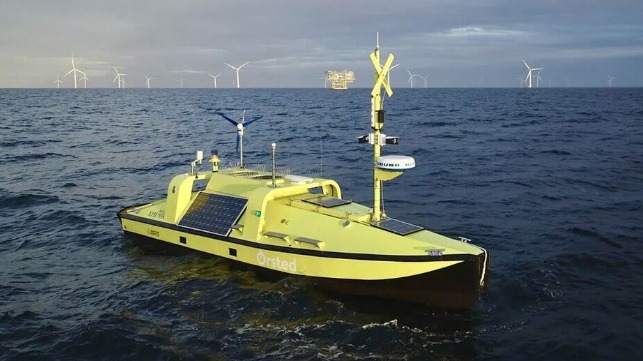Ørsted Develops Uncrewed Surface Measuring Vessel for Offshore Wind

As the pace accelerates to develop offshore wind energy projects, Ørsted, one of the leading developers of offshore wind farms, has developed the first uncrewed surface vessel specifically designed for offshore met-ocean measurement campaigns. According to the company, the vessel improves the efforts to gather data critical to early-phase development activities before construction while also improving safety and lowering overall costs with an increased operational window including high sea state conditions.
"What's so special about our USV concept is that it can bring our measurement equipment to and from our offshore sites without the need for large, specialized support vessels, and, while on-site, it can operate autonomously for extended periods of time, measuring large amounts of data that can be sent onshore and processed in real-time,” explains Frederik Søndergaard Hansen, Programme Manager and co-inventor of the USV concept.
A prototype USV, named Hugin USV, was developed in collaboration with industry partners. The prototype USV was constructed by the Danish shipbuilder Tuco Marine Group and the USV control system was delivered by the Norwegian company Maritime Robotics. The prototype vessel was tested in Danish and Norwegian waters and has been operational during hurricane conditions, where it experienced waves up to nine meters in the North Sea. Hugin USV the company reports has also achieved type validation as a floating LiDAR system by DNV, enabling it to be used for commercial operations related to wind farm development.
It is designed for continuous operation in the harshest offshore conditions for a year at a time. The USV has a built-in navigation system, which enables it to transit from shore at various degrees of autonomy, and it can be controlled both in line-of-sight or from a beyond-line-of-sight remote control center.
It is designed as a generic sensor platform and can collect large amounts of data on, among other things, the wind conditions, the state of the seabed, and biological and ecological measurements. This measurement data is used to help lower uncertainties in the expected annual energy production for new offshore wind farms. Ørsted, who has patented the USV concept, reports it sees enormous potential in the technology and has initiated a serial production based on their successful prototype USV. The expectation is to produce five new USVs by the end of 2023.
